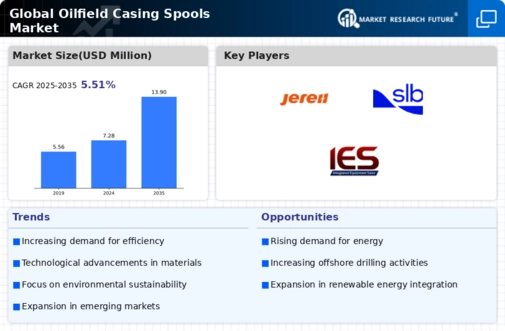Oilfield Casing Spools Size
Oilfield Casing Spools Market Growth Projections and Opportunities
The oilfield casing spools market operates within the broader oil and gas industry, specifically focusing on providing essential equipment for wellheads. These casing spools play a pivotal role in maintaining well integrity and facilitating the smooth functioning of oil and gas extraction processes. Understanding the market dynamics of this sector involves analyzing several key factors that influence its growth, demand, and fluctuations.
One of the primary drivers shaping the market dynamics of oilfield casing spools is the global demand for energy. As the world's population continues to grow, so does the need for oil and gas resources. This perpetuates the exploration and production activities in the oil and gas sector, subsequently bolstering the demand for casing spools. Economic factors and geopolitical events also significantly impact the market. Fluctuations in oil prices due to geopolitical tensions, trade agreements, or economic policies directly affect investment decisions within the industry, thereby influencing the demand for casing spools.
Technological advancements contribute significantly to the evolving landscape of the oilfield casing spools market. Innovations in drilling techniques, materials used in manufacturing spools, and automation in extraction processes drive efficiency and productivity. As companies strive to enhance operational efficiency and reduce costs, there's a continual demand for more advanced, durable, and cost-effective casing spools.
Regulatory frameworks and environmental concerns also exert notable influence. Stringent regulations pertaining to safety standards, environmental conservation, and emissions control impact the design, manufacturing, and usage of casing spools. Companies operating in this market must comply with these regulations, leading to investments in research and development for eco-friendly and compliant solutions.
Moreover, market dynamics are affected by the competitive landscape and industry consolidation. The market is populated by numerous manufacturers and suppliers competing based on product quality, pricing strategies, and after-sales services. Mergers, acquisitions, and collaborations within the industry reshape market dynamics by consolidating market share and influencing pricing trends.
Customer preferences and regional market variations further contribute to the market dynamics of oilfield casing spools. Different regions have distinct drilling requirements, geological conditions, and regulatory landscapes, leading to variations in demand for specific types or designs of casing spools. Understanding and adapting to these regional nuances are crucial for companies aiming to maintain a competitive edge.
Additionally, the market dynamics are also affected by factors like the availability of raw materials, skilled labor, and infrastructure. Fluctuations in the prices of raw materials used in manufacturing casing spools, alongside labor costs and infrastructure developments, impact production costs and subsequently influence market dynamics.
The oilfield casing spools market operates within a complex web of interrelated factors. Global energy demand, technological advancements, regulatory frameworks, competition, regional variations, and resource availability collectively shape the market dynamics. Adapting to these ever-evolving dynamics is crucial for companies operating in this sector to thrive and meet the evolving needs of the oil and gas industry.







Leave a Comment